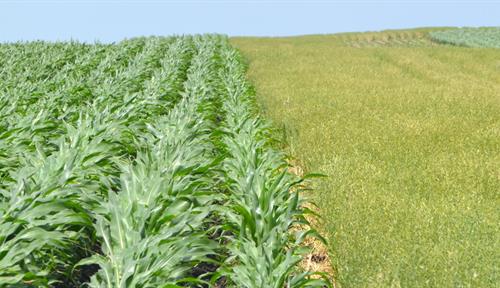Cleaning up cow burps to combat global warming
New tools for lowering methane emissions from livestock are on their way
Support sound science and smart stories
Help us make scientific knowledge accessible to all
Donate today
In the urgent quest for a more sustainable global food system, livestock are a mixed blessing. On the one hand, by converting fibrous plants that people can’t eat into protein-rich meat and milk, grazing animals like cows and sheep are an important source of human food. And for many of the world’s poorest, raising a cow or two — or a few sheep or goats — can be a key source of wealth.
But those benefits come with an immense environmental cost. A study in 2013 showed that globally, livestock account for about 14.5 percent of greenhouse gas emissions, more than all the world’s cars and trucks combined. And about 40 percent of livestock’s global warming potential comes in the form of methane, a potent greenhouse gas formed as they digest their fibrous diet.
That dilemma is driving an intense research effort to reduce methane emissions from grazers. Existing approaches, including improved animal husbandry practices and recently developed feed additives, can help, but not at the scale needed to make a significant global impact. So scientists are investigating other potential solutions, such as breeding low-methane livestock and tinkering with the microbes that produce the methane in grazing animals’ stomachs. While much more research is needed before those approaches come to fruition, they could be relatively easy to implement widely and could eventually have a considerable impact.
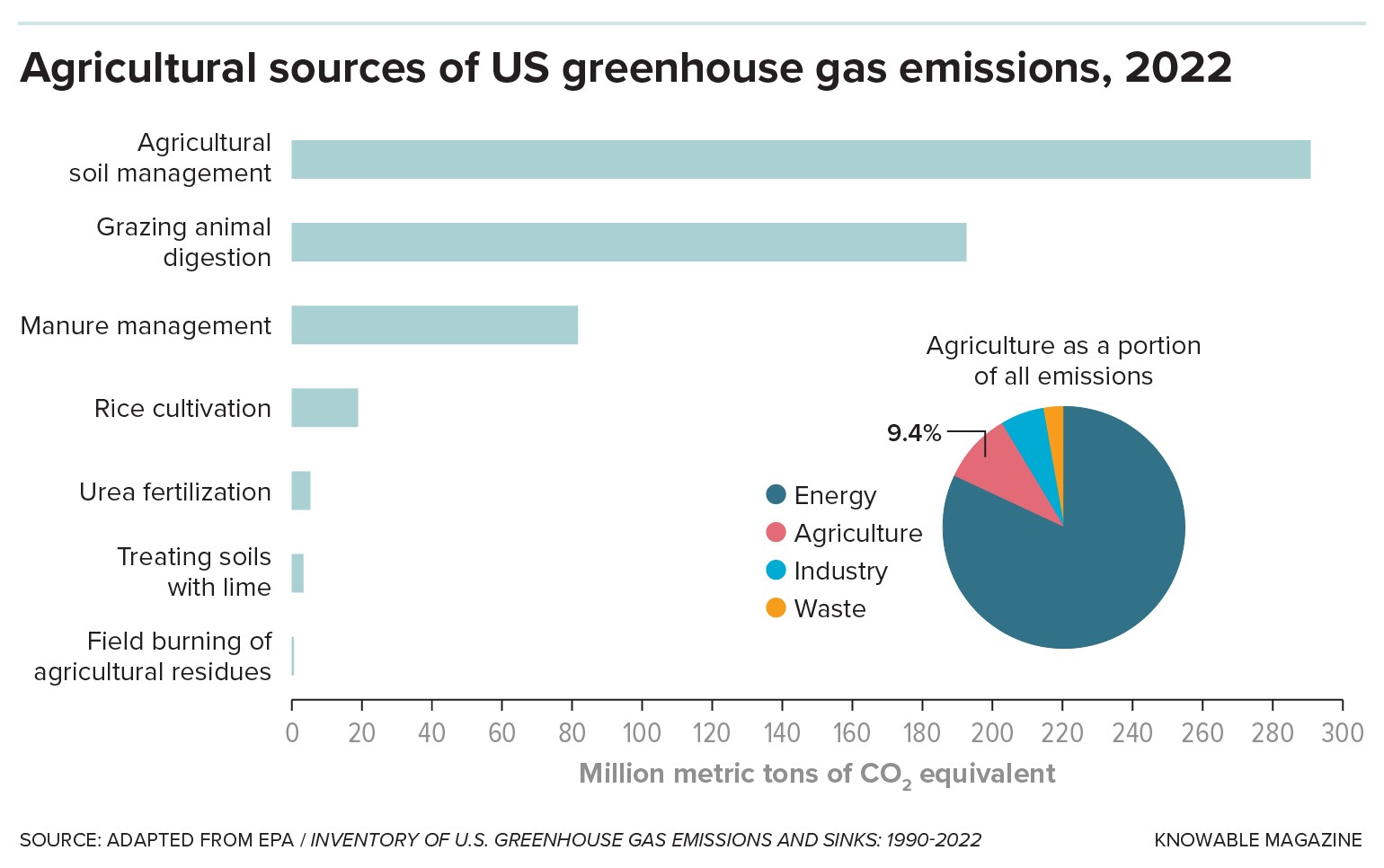
Methane from digestion by grazers is the second-leading source of agriculture-related greenhouse gas emissions in the US. It’s topped only by soil management, which includes activities such as plowing that release carbon stored in the soil. Methane emitted by stored manure from feedlots and dairies comes next, with other sources contributing smaller amounts.
The good news — and an important reason to prioritize the effort — is that methane is a relatively short-lived greenhouse gas. Whereas the carbon dioxide emitted today will linger in the atmosphere for more than a century, today’s methane will wash out in little more than a decade. So tackling methane emissions now can lower greenhouse gas levels and thus help slow climate change almost immediately.
“Reducing methane in the next 20 years is about the only thing we have to keep global warming in check,” says Claudia Arndt, a dairy nutritionist working on methane emissions at the International Livestock Research Institute in Nairobi, Kenya.
The methane dilemma
The big challenge in lowering methane is that the gas is a natural byproduct of what makes grazing animals uniquely valuable: their partnership with a host of microbes. These microbes live within the rumen, the largest of the animals’ four stomachs, where they break down the fibrous food into smaller molecules that the animals can absorb for nutrition. In the process, they generate large amounts of hydrogen gas, which is converted into methane by another group of microbes called methanogens.
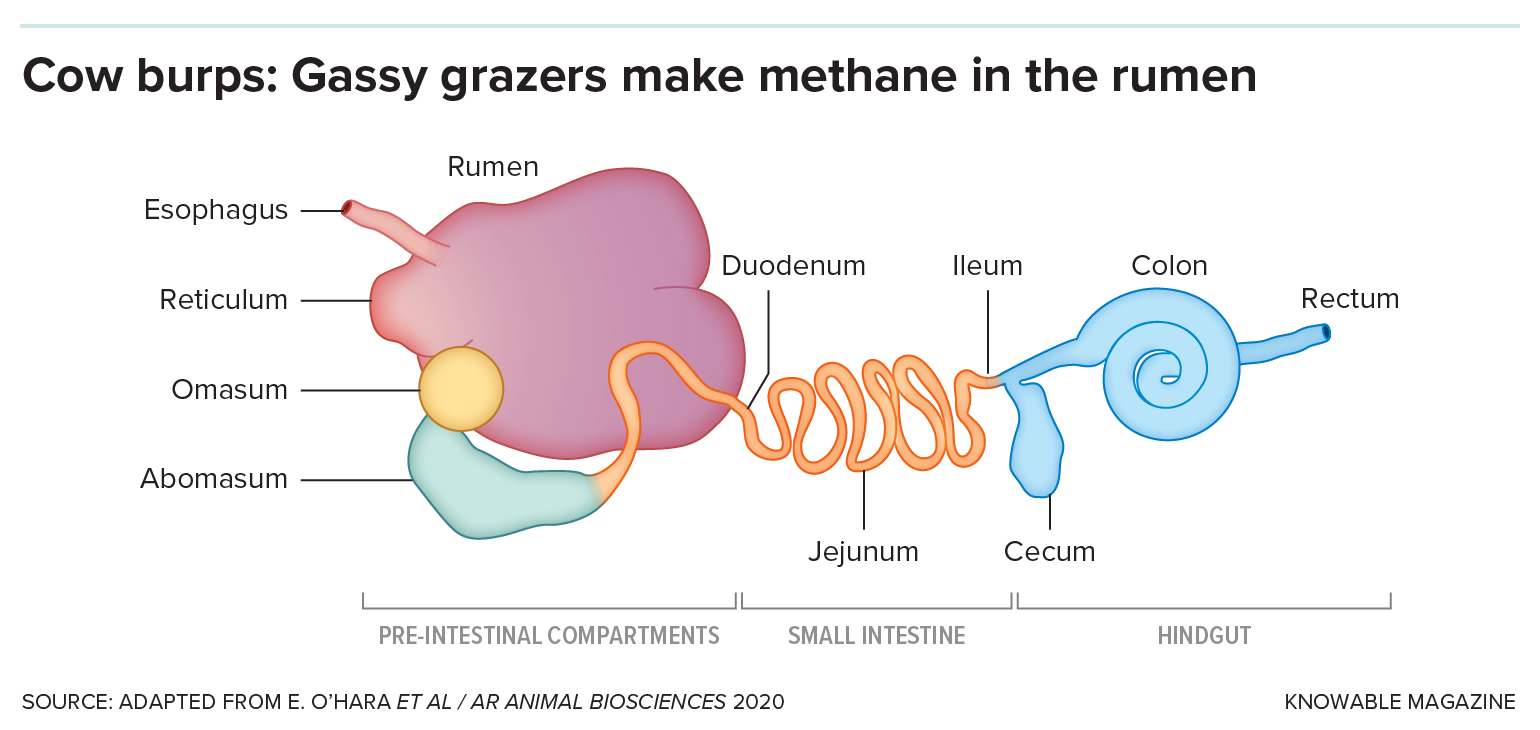
The microbes that digest fiber — and those that produce methane — live mostly in the rumen, the first and largest of a cow’s four stomachs.
Most of this methane, often referred to as enteric methane, is belched or exhaled out by the animals into the atmosphere — just one cow belches out around 220 pounds of methane gas per year, for example. (Contrary to popular belief, very little methane is expelled in the form of farts. Piles of manure that accumulate in feedlots and dairy barns account for about a quarter of US livestock methane, but aerating the piles or capturing the methane for biogas can prevent those emissions; the isolated cow plops from pastured grazing animals generate little methane.)
Enteric methane is tricky to capture and to curb, largely because grazing animals are moving around as they produce it. The most obvious way to address it is to make sure that livestock are as healthy and productive as possible through measures such as vaccinating against diseases, preventing parasites and providing plenty of nutritious food — steps that are especially important in poorer regions. That doesn’t reduce an animal’s methane output, but it does mean they emit less methane per pound of meat or gallon of milk, a measure called emissions intensity.
The problem with this approach, Arndt notes, is that reducing emissions intensity does nothing to reduce the absolute amount of methane in the atmosphere unless farmers compensate for the increased production by reducing their herd sizes, rather than increasing their total output.
Researchers don’t have enough data yet to know how much productivity-improving measures like these could reduce emissions intensity globally. However, the few studies that have been done — mostly on dairy animals — suggest that reductions could be about 10 percent to 15 percent or more, according to a 2022 review in PNAS by Arndt and her colleagues.
Improving productivity is important — but it’s only a first step, says Hayden Montgomery, program director for agriculture at the Global Methane Hub, a philanthropic collaborative that coordinates and funds methane-mitigation research. “It’s not sufficient in itself to achieve the levels of reduction we want, but it’s certainly the right place to start.”
The only strategy for reducing total methane output that’s ready to go today is a synthetic feed additive. Called 3-nitrooxypropanol (3-NOP), the additive absorbs some of the hydrogen produced in the rumen before methanogens can use it. It has been approved in some countries, including recently the US and Canada, and has been shown to reduce methane emissions by more than 30 percent.
Other potential feed additives are being investigated, says Diego Morgavi, an animal scientist at the French National Research Institute for Agriculture, Food and Environment who coauthored a review of ways to mitigate enteric methane in the 2024 Annual Review of Animal Biosciences. Red algae, for example, produce a molecule called bromoform that blocks the last step in the production of methane and thus can reduce emissions by up to 90 percent. But it is toxic, and it’s not clear whether such alterations to the rumen’s microbiology are safe in the long term.
In any case, such additives may not be practical for many farmers, since they increase costs without any clear boost to productivity. “Who’s going to pay for that?” asks Arndt. And livestock need to eat them every day — a logistical impossibility for the majority of the world’s ruminants, which graze freely in pastures. “That’s the big problem — there are no ways to control the emissions from grazing animals,” says Kristen Johnson, an animal scientist at Washington State University.
Breeding for low-methane burps
For free-roaming livestock, another promising option is to breed animals that emit less methane. For sheep or cattle, animals of the same size and identical diet can have methane outputs that vary by as much as 30 percent or 40 percent. “That’s a lot of diversity to play with,” says Montgomery. The trait appears to be as heritable as many other traits that breeders routinely select for, and breeders have already begun incorporating methane production into their selection criteria for Canadian dairy cattle, Irish beef cattle and New Zealand sheep.
Measuring the impacts of such breeding programs on methane production is challenging in free-ranging animals, but researchers at Colorado State University are working on a solution, using a freestanding belch-capturing chamber that can be set out in a pasture. Whenever a cow approaches the unit, an electronic ear tag identifies the individual. If researchers want a methane measurement from that animal, a chime sounds and the unit dispenses a treat into the chamber. As the cow puts its head in and munches its reward, a fan draws air from the chamber and the unit measures how much methane the cow belches out.
Researchers are using a mobile methane-measuring system, shown here, to record methane emissions by free-ranging cattle grazing in pastures. When the system detects the electronic ear tag of a cow it wants to measure, it releases a treat into the chamber and beeps to attract the cow. As the cow munches its treat, the machine measures how much methane the animal’s exhaled breath contains.
CREDIT: C-LOCK INC. / REBECCA BADER
Other research is exploring easier ways to measure an animal’s methane output. It might be possible to extrapolate an animal’s long-term methane production from a single spot measurement, for example, or by genetically profiling its rumen or mouth microbes. There are even suggestions that the chemical composition of a dairy cow’s milk might signal its methane output. Combining several such measurements could lead to much more reliable data, says Montgomery. “That would be a game changer.”
Montgomery hopes that livestock bred to emit less methane will be widespread within a decade, at least in countries with robust livestock breeding programs. The advantage of such breeding programs, compared with feed additives, is that the emissions reductions they achieve are permanent and hereditary, requiring no further effort or cost on the part of farmers or herders.
Modifying microbes
Tinkering with the bovine microbiome could also provide new ways of reducing methane emissions. An analysis of 750 Danish dairy cows suggests that in addition to the animal’s genetics, the mix of microbes in its rumen also has an independent effect on the amount of methane a cow produces.
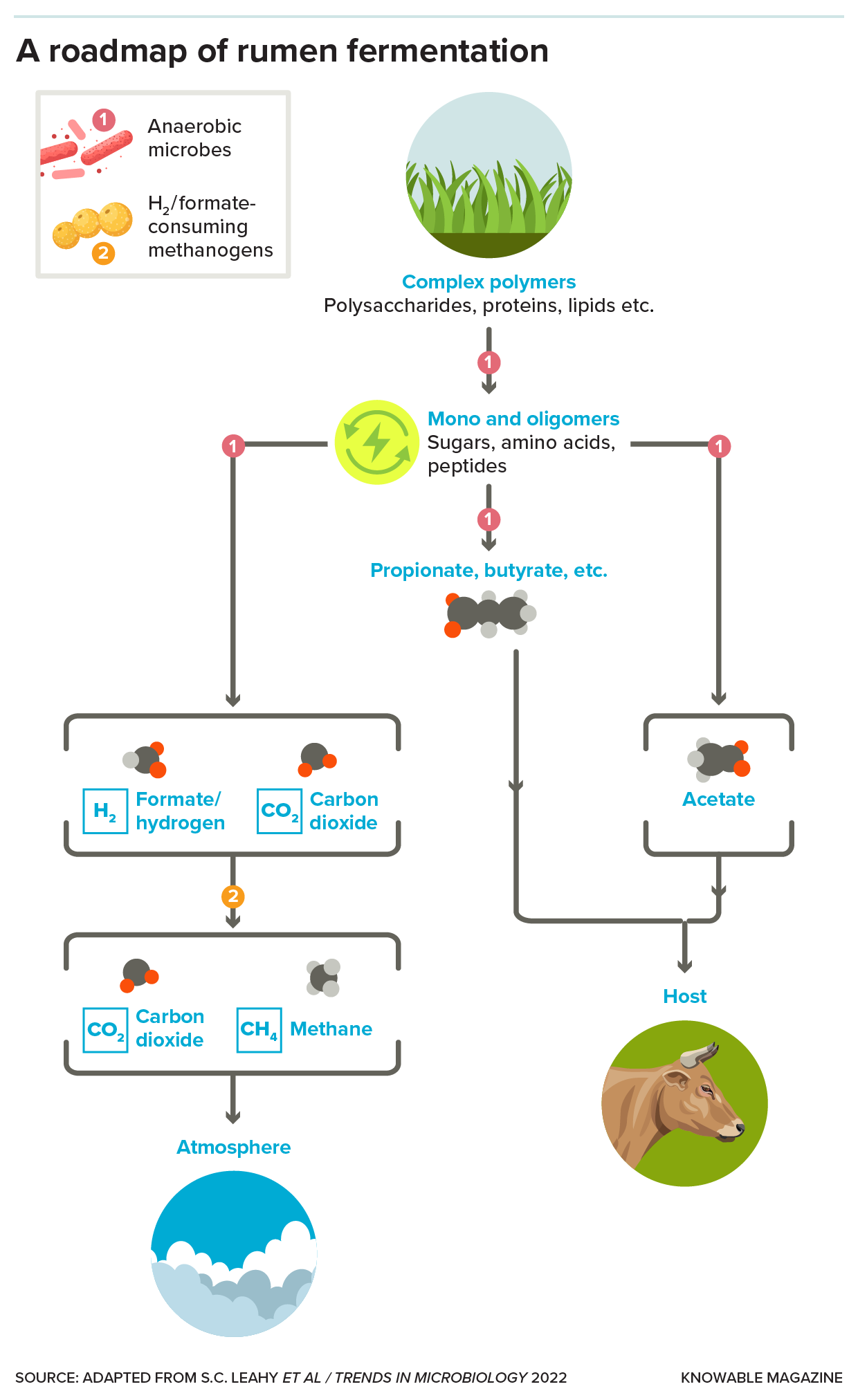
Microbes in the rumen break large molecules — especially cellulose — into smaller subunits. Some of these nourish the cow, while others are food for methane-producing microbes called methanogens. Researchers are searching for ways to shift the mix of microbes in ruminant guts to minimize methane emissions.
Shifting the balance toward microbial species that use the rumen’s hydrogen to produce other molecules such as acetate, propionate and fatty acids, which — unlike methane — can all be used as energy sources by the grazer, is one promising option, says Leluo Guan, an animal microbiome researcher at the University of British Columbia. Guan is now part of a team studying the fate of hydrogen in the rumen, tracking how much goes into methane and how much to these more beneficial molecules. By comparing high- and low-methane-emitting animals, they hope to identify ways to shift the hydrogen balance toward less methane.
“Basically, you need to take the hydrogen and put it someplace else efficiently,” says Matthias Hess, a microbiologist at the University of California, Davis. Working with artificial rumens — sealed chambers in the laboratory — Hess aims to make this nudge more precise by using the gene-editing technology CRISPR to alter rumen microbes in ways that reduce methane production. He hopes to have useful lab results in two or three years, and modified microbiota ready to transplant into animal rumens within five to seven years. What he learns in his artificial rumen research should also apply to other methane-emitting environments such as wastewater lagoons and manure piles, he says.
Even if Guan, Hess and others succeed in creating a less methanogenic microbe mix, however, it’s not clear whether it will be possible to deploy such a mix in real animals. The microbiomes of ruminant animals are notoriously resistant to change: When researchers eradicate the existing microbes and replace them with new ones, the microbiome often reverts to its former state quickly.
Acting early in an animal’s life might yield better success. Morgavi and his colleagues treated nine newborn calves with the 3-NOP additive for the first 14 weeks of their lives. Because 3-NOP starves methanogens of hydrogen, it puts them at a disadvantage in the rumen’s ecosystem during this crucial period when microbes are colonizing the rumen.
Sure enough, the treated calves ended up with different microbial communities from those of eight untreated control calves — and, crucially, this difference persisted for the entire 60 weeks of the experiment, the researchers reported in 2021 in Scientific Reports. This suggests there might be a critical window during which farmers could shape the rumen’s biota for the animal’s lifetime, says Morgavi, who adds that the study still needs to be validated by other groups and under other conditions.
Methane-reducing jabs
Another way to shift the rumen’s microbial community away from methanogenesis could be to vaccinate livestock against methanogenic microbes. Such a vaccine, researchers hope, would prime the animal’s immune system to produce antibodies that bind to the methanogens in the rumen and inactivate them. Because vaccination is already well accepted by farmers, and animals would only need occasional booster shots, it could be a more practical solution than daily feed supplements.
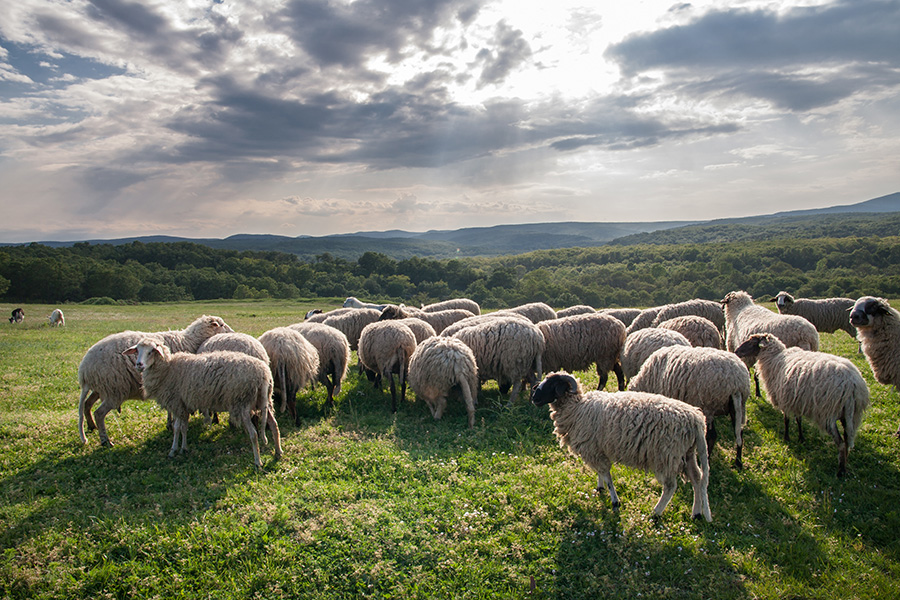
Sheep, like cattle, are ruminants whose stomachs contain methane-producing microbes. Researchers hope that a vaccine that inactivates those microbes can help reduce methane emissions.
CREDIT: DECHEVM / STOCK.ADOBE.COM
A team led by immunologist Neil Wedlock, of AgResearch, a research institute owned by the New Zealand government, has been working for nearly two decades to develop such a vaccine in sheep. So far, the team has shown that vaccinated sheep do produce lots of methanogen-targeting antibodies in their saliva — enough to inactivate all the methanogens in the rumen. They’ve also shown that this reduces methane production in test-tube cultures. If a vaccine works, the team hopes it can reduce methane emissions by about 30 percent, Janssen says. So far, however, they haven’t produced consistent reductions in methane emissions from live animals.
With the world facing an urgent need to reduce methane to contain climate change, and little political will to reduce consumption of beef and milk, controlling enteric methane may be one of our best hopes to meet crucial climate goals, says Montgomery. However, it will take time for today’s promising research to mature into deployable technologies.
“Realistically, I’m not expecting we’re going to have a 30 percent reduction in livestock methane by 2030,” says Montgomery. “But could we imagine a 50 percent reduction by 2050? Definitely — and maybe more.”
10.1146/knowable-061024-1
TAKE A DEEPER DIVE | Explore Related Scholarly Articles






